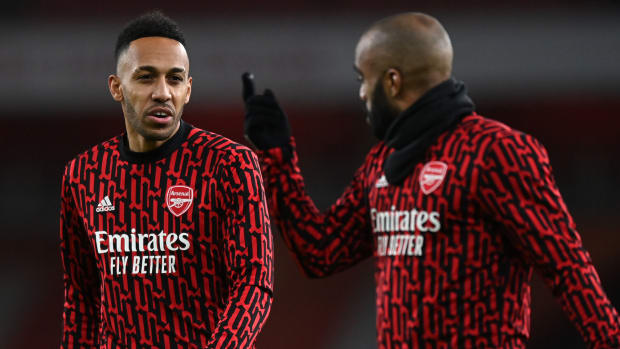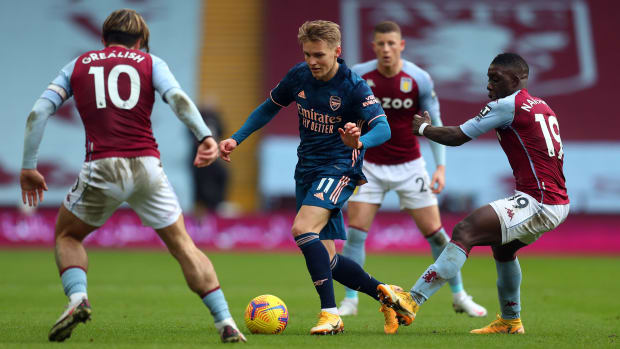If there's been one constant for Arsenal this season, it's been the rollercoaster nature of its play. Why is it that the Gunners can't sustain a good run of form?
Mikel Arteta’s tenure in North London couldn’t have begun on a much better note.
The former Arsenal captain was hired as the club’s manager in Dec. 2019 after a string of poor performances left Unai Emery sacked. What immediately followed was promising. The Gunners won half of their remaining Premier League games, including an eight-week unbeaten stretch that ran from late December to the June restart. They climbed from 12th in the table up to a substandard-but-hopeful eighth. His first half-season in charge was then capped with an FA Cup title. Not bad for a first-time manager running an underperforming team during a global pandemic.
Six months after lifting the trophy, Arsenal is back in the middle of the table with just an outside shot at participating in European competition next season. So where have Arteta and his club gone wrong?
We’ll start with those things out of the Spaniard’s control. Injuries have plagued the Gunners since the start of the season. Kieran Tierney, one of their few bright spots this season, has missed six games already and will likely miss more due to an injury suffered nearly a month ago. Thomas Partey, the club’s biggest transfer of the 2020 summer window ($58 million), has made just nine league starts (and played 90 minutes just three times) as he’s battled through a litany of knocks.
It’s not that Arsenal is alone in that regard. Many other squads, namely Liverpool and Manchester City, have been hit with a laundry list of injuries following the condensed offseason. But without the depth of some of England’s top teams, Arsenal has been left without some of its most important players or comparable replacements.
Now, onto what Arteta can control. Arsenal’s biggest problem isn’t a lack of quality. It’s a lack of consistency. Its season has been one of streaks—six weeks without a Premier League victory during November and December, then seven weeks without losing that immediately followed. The injuries surely played a part, but the Gunners’ lack of discipline and attacking identity has kept them pinned in the middle of the table.
It doesn’t take any advanced stats to comprehend how a league-leading five red cards have hurt Arsenal. It managed to pick up a point in two matches in which a player was sent off, but lost to Burnley after a booking of Granit Xhaka in the second half and then to Wolves when David Luiz and Bernd Leno both picked up straight reds.
When at full strength, the Gunners actually don’t have too many defensive issues. Even with the revolving door on the back line, Arsenal is sixth in the Premier League in opponent xG and tied for fourth in goals conceded. Leno has put together one of the better seasons of any Premier League goalkeeper this year (+3.1 xG minus goals allowed, currently seventh in the league). The disconnect arrives in the midfield and in the deployment of forwards Pierre-Emerick Aubameyang and Alexandre Lacazette.

For much of Arsenal's middling winter run, the offensive “creation” came primarily from a slew of balls sent from the wingers into the box. In a 2-0 loss to Tottenham on Dec. 6, Arsenal attempted 34 crosses compared to Spurs’ three. That isn’t especially conducive to goal creation, given Aubameyang and Lacazette have put home just six headers total in the last two seasons.
The lack of linkup play has turned the usually-energizing attacking duo into a shell of their old selves. Both players are averaging their lowest non-penalty xG per 90 minutes since the stat was first tracked by fbref.com in 2017.
Both attackers have spent time at center forward, but neither has appeared totally comfortable in Arteta’s scheme. Aubameyang has played on the left wing and in the middle. He was hardly effective in the latter spot during Arsenal’s winless streak (1.4 xG in six games). On the wing, he simply doesn’t see enough involvement in the attack to produce dangerous chances.
Lacazette, on the other hand, has tried to get involved in the buildup, but to no avail. He’s taken more touches in the middle third of the field per 90 minutes than Aubameyang and far fewer in the attacking third. Even though Arteta has attempted to thrust him into the attack by dropping him deeper, he’s averaging the lowest number of shot-creating actions per 90 minutes of his four years with the club.
They’re not necessarily square pegs in round holes. They’re just players whose skill sets seem to be a mismatch with their manager’s tactics. So how does a team change their cross-happy ways to create real, dynamic, dangerous scoring chances? Enter Emile Smith-Rowe.
The 20-year-old made his first Premier League appearance since 2019 in December, recording an assist in what was probably Arsenal’s best performance of the season, a 3-1 thrashing of Chelsea. That performance was a glimpse of what was to come.
Smith-Rowe leads the Gunners with 0.23 expected assists per 90 minutes in Premier League competition. He has the most goal-creating actions per 90 minutes (0.79) and fourth-most shot-creating actions per 90 (2.84). Arsenal is, simply put, much better with him on the pitch—2.12 net goals per 90 minutes better, in fact.
Smith-Rowe isn’t going to be his team’s savior. But it’s clear that the young attacking midfielder has a key role as his squad’s primary creator going forward. How everyone else fits into the Arsenal attack is less obvious.

Aubameyang staked his claim at center forward with a hat trick against Leeds last Sunday. Martin Ødegaard, on loan in North London for the rest of the season from Real Madrid, made his first start in the 4–2 win and looked like a strong option as the central attacking midfielder, with Smith-Rowe and young star Bukayo Saka making runs on either side. Maybe the most important stat of the day: Arsenal attempted just six crosses!
That leaves Lacazette, $88-million transfer Nicolas Pépé and Willian with the scraps of minutes off the bench. But maybe that’s O.K.—for now. Arsenal drew Benfica in the first leg of their Europa League round-of-32 matchup on Thursday, with Lacazette remaining on the bench and Pépé and Willian being used as substitutes. Now it’s back to the grind of the Premier League season against league leader (and likely league winner) Manchester City on Saturday.
It’s a tall task for Arteta’s squad to battle back into the European competition spots with 14 matches to go. But there’s still time to prove a few things: that Arsenal isn’t finished, that the midseason win drought was the product of a conglomeration of external issues and that there’s sustained hope, at last, for the present and for the future.